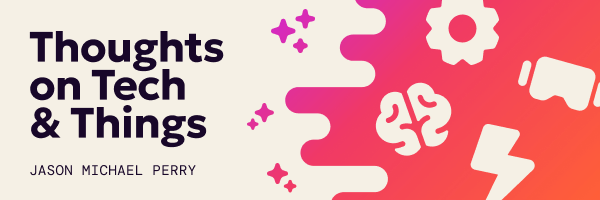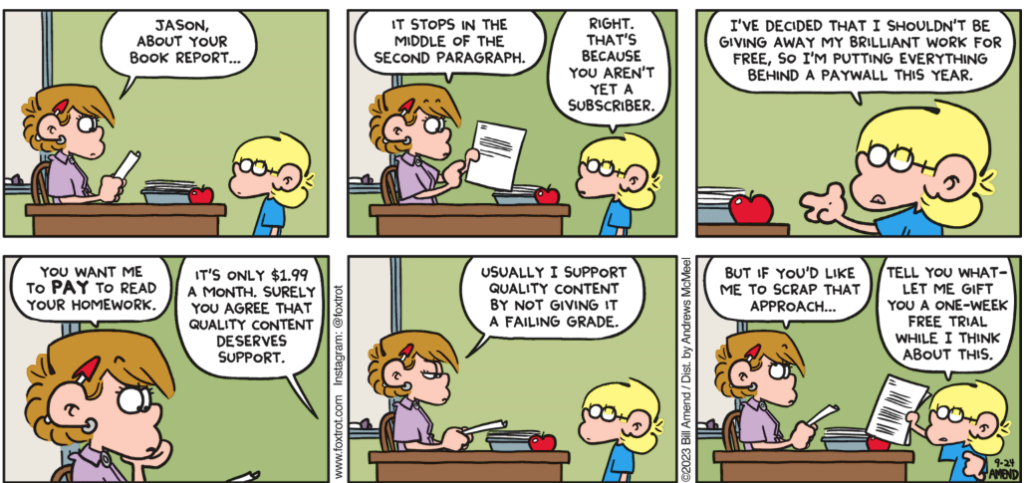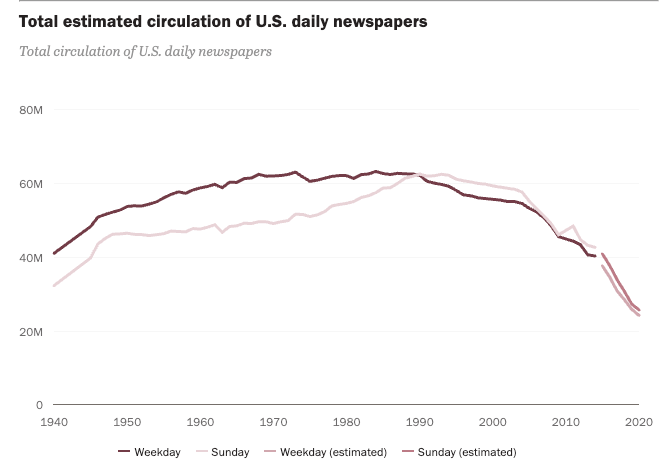Issue #18: Paywalls and gated content for the win?

Howdy👋🏾. The Baltimore Sun published a well-timed article about ‘AI in A-minor,‘ a first-of-its-kind event showcasing classical music composed by artificial intelligence. If you follow the link, which I highly recommend, you’ll find yourself in one of two categories: those with a Baltimore Sun account and those without.

Paywalls are a form of gated content, a tactic of locking content until a user pays a fee or shares personal information like their email address or phone number. In the digital marketing world, this is a great way to incentivize lead capture of contact information in exchange for something of value, such as ebooks, white papers, or a recorded webinar. There is great debate in many marketing communities on how well this works. Some point to increased revenue or leads as direct signs that they do work, while others see it as a dark user experience pattern that yields high bounce rates, a statistic that tracks the percentage of people who leave or abort a page, as a sign that it scares away potentially valuable users.

Print and digital content circulation has declined for newspapers, especially daily papers, forcing them to get creative about revenue. The New York Times and Washington Post were early adopters of paywalls and saw great success, but as the tactic has caught on, more groups are duplicating their efforts, making more of our news inaccessible. Even the social platform X (formerly Twitter) announced that it might move all its content behind a paywall.
The paywall question boils down to a simple question, is the reduction in readership worth the upside of increased revenue? Howard Stern is an interesting case study. Before he signed with SiriusXM radio, his show was available on public radio stations to a much larger audience for “free” (ad-supported like local TV). His landmark deal gated his show behind a satellite radio subscription and reduced his overall listener count while giving him a much larger slice of the revenue pie. Regardless of lower listener numbers, the man remains among the highest-paid radio hosts and a huge attraction to SiriusXM. Joe Rogan followed a similar path with Spotify, making some of his content exclusive to subscribers. In both these cases, two things quickly happened, their content became less discoverable and, for some, reduced how often it’s referenced in our daily lexicon:
“However, a new data investigation by The Verge finds that the powerful podcaster’s influence has waned since he went behind Spotify’s wall. His show has declined as a hype vehicle for guests, and Rogan’s presence as a mainstay in the news has plummeted.”
If it sounds like I’m against paywalls, I’m not. Creators must eat, and writing content like this newsletter takes real work. Paywalls and subscription-based business models have become such a common approach to monetization that it’s hard to pick and choose when it feels like too many people have their hands out. I assume some of Howard Stern and Joe Rogan’s success is that both the platforms they joined represent a marketplace with tons of content. Similarly, reading platforms like Medium, Substack, and Apple News are great because I get access to so much more than I do when I subscribe directly versus paying each podcast, magazine, and newspaper an increasingly higher monthly fee.
Once upon a time, paywalls also stood as a sign of high-quality exclusive content. Paying for HBO gave a better cable experience with fewer ads and fantastic content, but that promise feels broken when content diminishes and ads become more intrusive. Models focusing on freemium content, special paid exclusives, or other extras feel more consumer-friendly but do not always maximize potential revenue. Freemium models have led to the continued dilution of lower-cost offerings, as seen with Netflix and Amazon bringing ads to their lower-tier offerings to increase MRR (Monthly Recurring Revenue).
Daily papers find themselves in a more challenging place; the relevancy of these storied institutions is built on how accessible their content is. If the daily paper featured something, it instantly meant every household had it in their hands, and if you couldn’t afford it, you could probably grab a copy at the local coffee shop, barber, or office waiting rooms. Nowadays, that distribution level is gone, and with that is fading relevancy. The paywall accelerates this, but reporters also have to eat.
Now here are some of my thoughts on tech & things:
⚡️California is quickly becoming the battleground for self-driving cars and now trucks. Governor Newsom’s vetoing of a bill requiring self-driving trucks to include a driver is enormous news making it the leader in self-driving laws and policy.
⚡️ MGM is still recovering from a hack that started with social engineering; read the profile on the Gen Z group who claims to be behind it.
⚡️Meta has AI bot ambitions and plans to embed fun bots with personalities into its platform. Having spent way more time than I expected chatting with bots, I think this might be much more compelling than expected.
One more thought on paywalls. Way too few companies that focus on subscriptions offer family accounts versus individual ones. If you have kids or a partner, you share an account for food delivery, grocery orders, or streaming accounts, and man, that is a struggle. I have teenage kids, and every few weeks, someone needs the password for Disney+, Netflix, or some other account we share. This excites me for Apple’s new iOS 17 feature for password sharing (something many households can also solve with a password manager), but the more significant issue is that the notion of one person, one account is wrong. It also leads to bad practices such as creating purposely easy passwords or sharing credentials insecurely over texts, emails, or on a pad on the fridge. Passwords suck, but I think it might be time to reimagine the entire dynamic of user account management and authentication.
-jason
P.s. I love my Apple devices and my watch, but I have limits to what I’ll do to save them. How far are you willing to go to save your smart device? ⬇️

